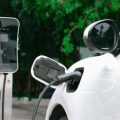Introduction to EV Charger Grants in the UK
The United Kingdom has seen a remarkable surge in electric vehicle (EV) adoption over recent years, fuelled by both environmental concerns and advancements in automotive technology. As British drivers increasingly shift their allegiance from petrol and diesel to electric, the convenience of charging at home has become a cornerstone of the EV ownership experience. Home EV chargers not only offer practical benefits such as overnight charging and cost savings but also ensure that motorists wake up to a fully charged car each morning—a far cry from the days of queuing at the filling station with a classic motor.
Recognising this shift, the UK government has rolled out various grants and support schemes to make home charger installation more accessible and affordable for households across England, Scotland, Wales, and Northern Ireland. These initiatives are designed to encourage the uptake of clean transport, help meet national net-zero ambitions, and ease the transition for those accustomed to traditional combustion engines. Government support can often make the difference between delaying or embracing EV ownership, particularly when factoring in the upfront costs associated with charger installation.
The table below highlights why home EV chargers are essential and how government backing plays a pivotal role:
| Aspect | Why It Matters |
|---|---|
| Convenience | Charge overnight at your own pace, no need for public charging queues |
| Cost-Efficiency | Lower electricity rates compared to public chargers; government grants reduce installation costs |
| Environmental Impact | Supports national goals for reducing emissions and improving air quality |
| Property Value | Increases desirability and future-proofs homes for an electrified future |
As more drivers consider making the switch to electric motoring, understanding the available grants and government-backed schemes becomes crucial. These programmes not only lessen financial barriers but also demonstrate a national commitment to sustainable transport—a modern solution rooted in classic British ingenuity.
2. Current UK Government Schemes and Incentives
The United Kingdom has been at the forefront of promoting electric vehicle (EV) adoption, not least through a series of government-backed grants and schemes designed to make home EV charger installation both accessible and affordable for the average motorist. Chief among these is the Office for Zero Emission Vehicles (OZEV) grant, formerly known as the Electric Vehicle Homecharge Scheme (EVHS). This initiative is aimed at encouraging more households to install dedicated EV charging points by offering financial support directly to eligible applicants.
OZEV Grant Overview
The OZEV grant provides a contribution towards the cost of purchasing and installing an EV chargepoint at domestic properties across the UK. Historically, this scheme covered up to 75% of the installation costs, capped at £350 per eligible charging point. It’s particularly targeted at homeowners, renters, and landlords alike, with different eligibility criteria depending on applicant status and property type.
Eligibility Criteria
| Applicant Type | Eligibility Requirements |
|---|---|
| Homeowners | Must own an eligible electric vehicle or have ordered one; off-street parking required |
| Renters & Flat Owners | Must have permission from freeholder or managing agent; off-street parking required |
| Landlords | Can claim for up to 200 chargepoints across their properties; must provide evidence of property ownership |
Aims of the Scheme
- Increase accessibility of home charging solutions for all residential property types
- Support the UK’s wider transition towards zero-emission vehicles by reducing barriers to entry
- Encourage early adoption and normalisation of EV ownership in anticipation of future bans on new petrol and diesel cars
Other Related Initiatives
Beyond OZEV, there are supplementary schemes such as the Workplace Charging Scheme (WCS) for businesses, and various regional incentives offered by local councils—some providing additional funding or expedited planning permissions. These initiatives together create a patchwork of support that reflects Britain’s commitment to a greener motoring future while preserving the charm of its classic motoring heritage.
![]()
3. Eligibility Criteria for Homeowners and Renters
When it comes to tapping into grants and government schemes for installing a home EV charger in the United Kingdom, eligibility plays a pivotal role. The criteria are shaped not just by one’s ownership status but also by property type and existing infrastructure. Here’s an in-depth look at who can apply, whether you own your home or are renting.
Homeowners: Requirements and Considerations
For property owners, the requirements tend to be more straightforward. Typically, you must:
- Own the residential property where the charger will be installed.
- Have off-street parking available (such as a driveway or garage).
- Possess an eligible electric vehicle or have one on order.
- Choose an approved installer registered with the relevant scheme (e.g., OZEV-approved).
Renters and Flat Owners: Navigating Permissions
If you’re renting or living in a flat, additional hurdles often come into play. However, schemes like the EV Chargepoint Grant now include provisions for these situations. Here’s a comparison:
| Status | Key Requirements |
|---|---|
| Private Tenant | Written permission from landlord; off-street parking; eligible vehicle |
| Flat Owner-Occupier | Proof of ownership; dedicated parking space; eligible vehicle |
Landlord Consent and Leasehold Challenges
Renters need written consent from their landlord, and those in leasehold properties may need approval from the freeholder or managing agent. Some local authorities offer advice or mediation services to help smooth this process.
General Conditions Across All Applicants
- The grant is available per household, not per individual.
- The charger must be installed by an approved professional.
- The property must be located within England, Wales, Scotland, or Northern Ireland (with some schemes varying by region).
Understanding these eligibility criteria helps applicants—whether homeowners or renters—navigate the process smoothly and increases their chances of securing support for greener motoring at home.
4. The Application Process: Step-by-Step Guidance
If you’re keen to benefit from the available grants and government schemes for home EV charger installation in the United Kingdom, it’s essential to understand the step-by-step application process. Getting your paperwork in order and following the correct procedure can make all the difference between a smooth installation and unnecessary delays. Here’s a practical rundown to help you navigate through the process like an old hand at fixing up a classic motor.
Step 1: Confirm Your Eligibility
Before anything else, check if you meet the criteria for your chosen grant or scheme. This usually involves:
- Being a homeowner or having landlord approval (if renting)
- Owning or leasing an eligible electric vehicle
- Having off-street parking at your property
Step 2: Choose an Approved Installer
The UK government requires that your home charger is fitted by an authorised installer registered with the scheme (such as OZEV – Office for Zero Emission Vehicles). Most reputable installers will be well-versed in grant paperwork and can offer valuable advice.
Step 3: Gather Required Documentation
Prepare all necessary documents before starting your application. You’ll typically need:
| Document | Description |
|---|---|
| Proof of Vehicle Ownership/Lease | Log book (V5C) or lease agreement for your EV |
| Proof of Address | Recent utility bill or council tax statement |
| Installation Quote/Invoice | From an approved installer, dated after scheme launch date |
| Landlord Permission (if applicable) | Written consent for tenants wishing to install chargers |
| Photographic Evidence | Pics showing off-street parking and proposed charger location |
Step 4: Submit Your Application
The application is often handled online via the government’s official portal, or sometimes directly through your installer who will submit on your behalf. Double-check every detail before submission – think of it as making sure you’ve torqued every bolt on a vintage Mini before hitting the open road!
Step 5: Await Approval and Installation
Once submitted, applications are reviewed for eligibility and completeness. Upon approval, your installer will schedule a date to fit your charger. Most grants deduct their contribution directly from your final invoice, so there’s no need for out-of-pocket claims later on.
Bumps in the Road?
If you hit any snags during the process – perhaps missing paperwork or eligibility confusion – don’t hesitate to ring up your installer or contact the relevant government helpline. They’re usually happy to lend a hand, ensuring British motorists keep motoring into a greener future with ease.
5. Approved Installers and Standards
When it comes to installing a home EV charger under UK grants and government schemes, choosing an approved installer is absolutely vital. Not only does this ensure your installation qualifies for funding, but it also guarantees safety, reliability, and compliance with British regulations. The Office for Zero Emission Vehicles (OZEV) mandates that only authorised installers can carry out grant-eligible installations. These professionals are registered with schemes such as NICEIC or NAPIT, demonstrating their competence in handling electric vehicle charge points.
Why Use an Approved Installer?
An OZEV-approved installer will:
- Ensure your charger is fitted correctly and safely to current UK wiring regulations (BS 7671).
- Provide all necessary certification upon completion—essential for both grants and home insurance.
- Offer expert advice on the best placement and type of charger for your property.
Key UK Standards for Home EV Chargers
All home charge points must comply with stringent British standards to qualify for support:
| Standard/Requirement | Description |
|---|---|
| BS 7671 (IET Wiring Regulations) | The benchmark for safe electrical installations in domestic properties. |
| OZEV Approval | Installer must appear on the official government list of approved EV chargepoint installers. |
| Smart Functionality | Chargers installed from July 2022 must be ‘smart’—able to schedule charging and respond to grid signals. |
| Part P Building Regulations | Ensures all electrical work meets legal requirements for household safety. |
Selecting the Right Installer: A Practical Checklist
- Check Credentials: Always verify the installer’s OZEV registration and relevant accreditations (NICEIC, NAPIT).
- Ask About Experience: Opt for those with a proven track record in fitting home EV chargers.
- Demand Documentation: Insist on receiving all compliance certificates post-installation.
- Get Quotes: Compare several approved installers—not just on price, but reputation and aftercare too.
A Nod to British Craftsmanship
Much like restoring a classic Morris Minor or keeping an old Triumph on the road, the right workmanship makes all the difference. Using trusted, certified hands ensures your investment in electric motoring stands the test of time—and keeps you eligible for every penny of government support available.
6. Additional Local Authority Schemes
While national grants such as the OZEV scheme provide a solid foundation for home EV charger installation, many local councils across the UK have launched their own initiatives to further encourage residents to make the switch to electric motoring. These regional programmes often offer supplementary funding or unique incentives, reflecting local priorities and addressing specific challenges within their communities.
Understanding Regional Differences
Local authority support varies considerably depending on where you live. Some councils provide top-up grants, while others focus on practical assistance, such as streamlined planning permission or community charging hubs in residential areas with limited off-street parking.
Examples of Local Council Initiatives
| Council/Region | Scheme Name | Support Offered | Eligibility |
|---|---|---|---|
| London Boroughs (e.g., Hammersmith & Fulham) | On-street Residential Chargepoint Scheme (ORCS) Supplement | Additional funding for curbside chargepoints outside homes without driveways | Residents without off-street parking; subject to application |
| Greater Manchester Combined Authority | EV Infrastructure Grant for Residents | Grants towards private and communal charger installation in flats and terraced houses | Multi-unit dwellings; local authority tenants and leaseholders |
| Cornwall Council | Cornwall EV Community Charging Initiative | Community-led funding for shared chargepoints in rural villages | Village associations and local parish groups |
| Scottish Borders Council | Sustainable Transport Fund Top-Up | Extra £200 per household when using Scottish Government EV grants | Main residence in the Scottish Borders; must meet national grant criteria |
| Birmingham City Council | Birmingham Clean Air Zone Support Package | Contribution towards home charger costs for residents upgrading from diesel vehicles | Birmingham CAZ area; proof of diesel scrappage required |
The Importance of Checking with Your Local Council
Given the patchwork nature of local schemes, it’s well worth contacting your council’s sustainability or transport team directly—or checking their website—for up-to-date details. Some regions also collaborate with energy suppliers or housing associations, offering time-limited pilot projects that may not be widely advertised.
A Nostalgic Nod: Community Spirit Recharged
This local approach echoes a bygone era, reminiscent of neighbourhood car clubs and the days when neighbours rallied together to restore an old Morris Minor. Today, these grassroots efforts are helping British motorists embrace a new generation of motoring—electric, clean, and future-ready—while keeping that sense of community firmly alive.
7. Looking Ahead: Future Grants and Changing Policies
The landscape of government support for home EV charger installation in the UK is by no means static. Over the past few years, government incentives have adapted to reflect new technology, shifting public priorities, and the country’s ambitious net-zero targets. As we look to the future, it’s clear that further changes are on the horizon.
Recent shifts, such as the evolution from the Electric Vehicle Homecharge Scheme (EVHS) to the more targeted EV Chargepoint Grant, demonstrate a trend towards focusing support where it can have maximum impact—namely among flat dwellers and those in rental accommodation. With an ever-increasing number of electric vehicles taking to British roads, policymakers are constantly reviewing how best to accelerate the installation of charging infrastructure at home and across communities.
Expected Policy Changes and Potential New Schemes
Government consultations suggest that future grants may prioritise not just private homeowners but also shared residential spaces and multi-occupancy buildings. There is talk within Whitehall corridors about expanding financial assistance for landlords who retrofit older properties with chargepoints, as well as possible incentives for smart chargers that can interact with grid demand. The table below outlines some anticipated areas of change:
Area of Focus |
Current Approach |
Potential Future Direction |
|---|---|---|
Eligibility Criteria |
Mainly homeowners and renters in flats/leaseholds | Broader inclusion of landlords and shared ownership schemes |
Technological Requirements |
Basic safety and functionality standards | Smart charging capabilities, integration with renewable energy sources |
Amount of Grant |
Capped at £350 per installation | Possible tiered support based on property type or location |
Environmental Considerations |
No specific requirements beyond EV usage | Tighter links to energy efficiency measures and green home upgrades |
A Nod to Nostalgia—and What It Means Going Forward
If you’re an old hand at motoring, you might remember when fitting a “car phone” was the height of domestic tech wizardry. Today’s shift to home charging evokes a similar excitement—a sense that something transformative is happening right on your driveway. But this time, it’s not just about convenience; it’s about contributing to cleaner air and a greener Britain.
The coming years will likely see even more targeted schemes, perhaps rewarding early adopters who combine solar panels with their home chargers or incentivising off-peak charging through smart metering. Whatever form these policies take, one thing remains certain: keeping an eye on official channels such as GOV.UK will be vital for staying ahead of the curve—and making sure you don’t miss out on valuable support as our roads go electric.


